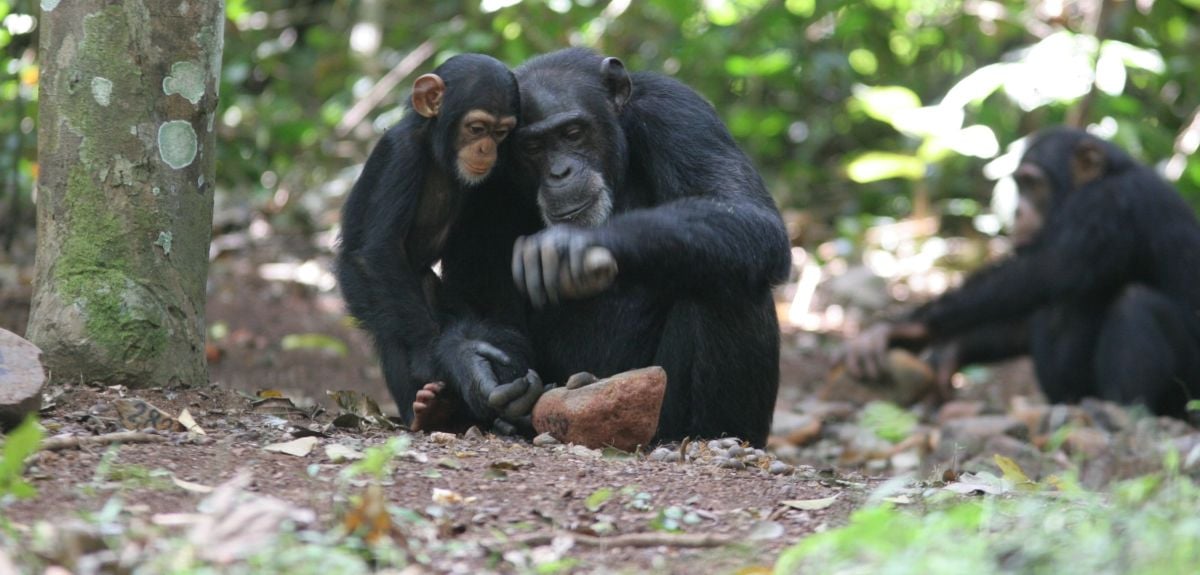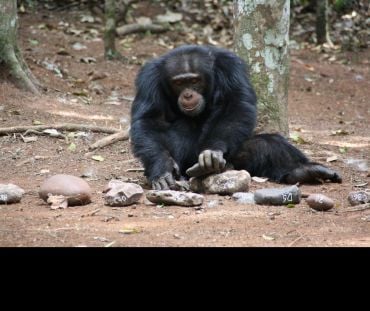
Study shows that chimpanzees perform the same complex behaviours that have brought humans success
A new study led by the University of Oxford suggests that the fundamental abilities underlying human language and technological culture may have evolved before humans and apes diverged millions of years ago. The findings have been published in the journal PeerJ.
Our results suggest that the sequences of actions that wild chimpanzees use to perform their tool-use behaviours share many properties with those of humans, and so likely evolved before the last common ancestors of humans and chimps.
Lead researcher Dr Elliot Howard-Spink
Many human behaviours are more complex than those of other animals, involving the production of elaborate sequences (such as spoken language, or tool manufacturing). These sequences include the ability to organise behaviours by hierarchical chunks, and to understand relationships between distantly separated elements.
For example, even relatively simple human behaviours like making a cup of tea or coffee require carrying out a series of individual actions in the right order (e.g. boiling the kettle before pouring the water out). We break such tasks down into solvable chunks (e.g. boil the kettle, get the milk and teabag, etc), composed of individual actions (e.g. ‘grasp’, ‘pull’, ‘twist’, ‘pour’). Importantly, we can separate related actions by other chunks of behaviour (e.g. you might have to stop and clean up some spilt milk before you continue). It was unknown whether the ability to flexibly organize behaviours in this way is unique to humans, or also present in other primates.
In this new study, the researchers investigated the actions of wild chimpanzees – our closest relatives – whilst using tools, and whether these appeared to be organised into sequences with similar properties (rather than a series of simple, reflex-like responses).

Using state-of-the-art statistical models, they found that relationships emerged between chimpanzees' sequential actions which matched those found in human behaviours. Half of adult chimpanzees appeared to associate actions that were much further along the sequence than expected if actions were simply being linked together one-by-one. This provides further evidence that chimpanzees plan action sequences, and then adjust their performance on the fly.
Understanding how these relationships emerge during action organization will be the next key goal of this research, but these could involve behaviours such as chimpanzees pausing sequences to readjust tools before continuing, or bringing several nuts over to stone tools that are then cracked in one long sequence. This would be further evidence of human-like technical flexibility.
Additionally, the results suggest that the majority of chimpanzees organise actions similarly to humans, through the production of repeatable 'chunks'. However, this result did not hold for every chimpanzee, and this variation between individuals may suggest that these strategies for organising behaviours may not be universal in the way they are for humans.
Interestingly, even the youngest chimpanzees in our study showed signs of organizing behaviors by chunks of actions. This suggests that this system of behavioral organization could be something which emerges very early in life.
Dr Elliot Howard-Spink
Lead researcher Dr Elliot Howard-Spink (formerly Department of Biology, University of Oxford, now Max Planck Institute of Animal Behavior) said: ‘Our results suggest that the sequences of actions that wild chimpanzees use to perform their tool-use behaviours share many properties with those of humans, and so likely evolved before the last common ancestors of humans and chimps. Archaeological evidence from other studies suggests that chimpanzees have been using stone tools for thousands of years, in a similar manner to today. Further research is needed to understand why humans can produce new technologies at such fast rates, whereas the tool-use behaviours of chimpanzees seem to change very slowly.’
As many great apes perform dextrous and technical foraging behaviours, it is likely that the capacity for these complex sequences is shared across ape species. More research is needed to validate this theory, and is a key goal for the team moving forward.
The researchers also plan to investigate how actions are grouped into higher-order chunks by chimpanzees during tool-use. This research will aim to clarify the rules that chimpanzees follow when generating their tool use behaviours. They will also investigate how these structures emerge during development and are shaped across adult lives.
The study ‘Nonadjacent dependencies and sequential structure of chimpanzee action during a natural tool-use task’ has been published in the journal PeerJ. The research was led by the University of Oxford with an international collaboration across the UK, US, Germany, Switzerland, and Japan.
 Expert Comment: The Modern Slavery Act at 10 – what have we learnt for human rights?
Expert Comment: The Modern Slavery Act at 10 – what have we learnt for human rights?
 Oxford tops national spinout rankings in 2025 report
Oxford tops national spinout rankings in 2025 report
 Former New Zealand Prime Minister Rt. Hon. Dame Jacinda Ardern to join Blavatnik School of Government’s World Leaders Circle
Former New Zealand Prime Minister Rt. Hon. Dame Jacinda Ardern to join Blavatnik School of Government’s World Leaders Circle
 Research into chimpanzee ‘engineers’ has implications for understanding human technological evolution
Research into chimpanzee ‘engineers’ has implications for understanding human technological evolution
 Study shows wild chimpanzees seek out medicinal plants to treat illness and injuries
Study shows wild chimpanzees seek out medicinal plants to treat illness and injuries
 Friendly monkeys have friendly microbes
Friendly monkeys have friendly microbes
 Monkey tool use threatens prey numbers, say researchers
Monkey tool use threatens prey numbers, say researchers